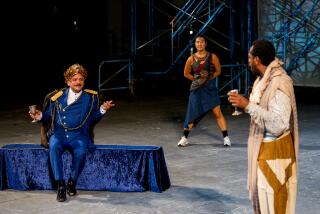A Passion for Tragedy
Hysteria, weeping, fainting spells by the dozen: Drury Lane theater audiences, among others, flocked to see the English tragic actress Sarah Siddons (1755-1831) in order to be wrecked, enthralled, destroyed, ennobled. A playgoer wrote of one performance that the “greater part of the spectators were too ill themselves to use their hands in her applause.” Acting to swoon over--literally.
Painters couldn’t get enough of her, and the other way around, which explains the sheer volume of portraiture devoted to “the Siddons.” Key examples thereof have been gathered for the Getty Museum’s current exhibition, “A Passion for Performance: Sarah Siddons and Her Portraitists” (through Sept. 19). One of the best, William Beechey’s 1793 “Sarah Siddons With the Emblems of Tragedy,” depicts the actress with a dagger in one hand and a tragic mask in another. She gazes at the viewer with a tinge of . . . amusement? Smugness?
What’s behind the mask behind the mask?
Dramatist Frank Dwyer ponders that one in “The Affliction of Glory: A Comedy About Tragedy.” Commissioned by the Getty, co-produced by the Center Theatre Group / Mark Taper Forum, the play is a curiosity, a sort of catalog accompanying the catalog accompanying the exhibition.
Dwyer’s not interested in straight-up theatrical biography, for which we can be grateful. Even as it succumbs to its own tricks and a gathering sense of tedium, “The Affliction of Glory” at least has the ambition to try a few things. Through thick and thin--and this play at times feels like both--director Corey Madden’s actors work valiantly and often charmingly to impart the right spirit.
A living monument to tragedy, Siddons apparently never got the hang of comic roles. Her Great Lady image was created through plays pockmarked with suffering, sacrifice, ill treatment at the hands of men. (Biographer Michael R. Booth, writing in “Three Tragic Actresses,” refers to her “pantheon of woe.”) “The Affliction of Glory” imagines Siddons (Nike Doukas) as somewhat vexed by all that suffering, no matter how lucrative.
The planes of reality shift continually in Dwyer’s lark. It begins with Siddons sitting for portraitist Sir Joshua Reynolds (JD Cullum). Siddons’ actor brother, John Philip Kemble (Patrick Egan), breaks the action, offering us his observations regarding his sister’s talent and fan base, royalty included. No newfangled Edmund Kean-style acting for this bloke; he speaks to us in archaic declamatory fashion. Dwyer, director Madden and the cast fare especially well when gently tweaking late-18th and early-19th century performance aesthetics, heavy on the woe-is-me gesticulation and rolling-thunder vowel sounds.
Doukas and Cullum also play Polly and Bill, in the present day--actors (and, presumably, a married couple) rehearsing Bill’s play about Siddons and Reynolds, commissioned by the Getty. How, Polly wonders, can a contemporary performer unlock whatever it was that made Siddons “unbearably moving”? Eager to find out, the couple rehearses scenes from various Siddons vehicles, lesser-known weepies such as “Venice Preserved” and “Isabella,” along with Shakespearean triumphs Siddons enjoyed, “Henry VIII” and “King John.”
So “The Affliction of Glory” goes, flip-flopping and shape-shifting. Its formal playfulness recalls Stoppard’s “Arcadia,” as well as Stoppard’s more recent “Indian Ink” and “The Invention of Love.” Dwyer takes on a lot, and he can’t quite make all of it work, especially the more tedious Polly/Bill rehearsal scenes.
Doukas, a fine and distinctive performer, is fundamentally miscast as Siddons. It’s not so much that she’s not ideal physically, though the matronly Siddons presumably was a more formidable and regal presence. But Doukas, who was wonderful in Dwyer’s 1994 production of the early Chekhov play “The Wood Demon,” staged at the Taper, gravitates naturally toward sprightliness and esprit. She can do the other stuff, but her bright smile (which she has a tendency to over-employ) and easy way with comedy is at odds with a character famous for her lack of humor.
For better or worse, Cullum and Egan get the tastiest material; Dwyer finds clever ways to circulate his two-man, multicharacter supporting roster. Both actors are skillful throughout. Madden acknowledges the limitations of the Getty’s Williams Auditorium, relying on the simple rehearsal-setting scenic solutions of John Iacovelli, Geoff Korf’s warm lighting and especially the elegant costumes of Candice Cain.
The results are sometimes amusing, more often reiterative and attenuated. Siddons remains elusive. The play peppers us with names, facts, footnotes: You wish novice playwright Dwyer--already an accomplished translator and director--had gone further and really taken us for a spin. As is, despite some artful flourishes, “The Affliction of Glory” leaves you wondering what everybody was passing out about.
* “The Affliction of Glory: A Comedy About Tragedy,” Harold M. Williams Auditorium, the Getty Center, 1200 Getty Center Drive, Los Angeles. Thursdays-Fridays, 8 p.m.; Saturdays, 2:30 and 8 p.m.; Sundays, 2:30 p.m. Ends Sept. 5. $22-$28. (213) 628-2772. Running time: 2 hours, 35 minutes.
Nike Doukas: Sarah Siddons, Polly
JD Cullum: Sir Joshua Reynolds,
Bill, Sid, Tempesti
Patrick Egan: Mac, John Philip Kemble,
Ralph, Goede, Will Blake, Gordon, Foyle, King George III, Richard Brinsley Sheridan,
Stukely, Hazlitt
Written by Frank Dwyer. Directed by Corey Madden. Set by John Iacovelli. Costumes by Candice Cain. Lighting by Geoff Korf. Projections by Marc Rosenthal. Wigs by Carol Doran. Music supervision by Nathan Birnbaum. Production stage manager David S. Franklin.
More to Read
The biggest entertainment stories
Get our big stories about Hollywood, film, television, music, arts, culture and more right in your inbox as soon as they publish.
You may occasionally receive promotional content from the Los Angeles Times.










